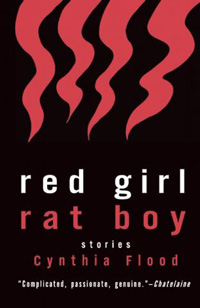Reviews
Fiction Review by Carol Matthews
Cynthia Flood, Red Girl, Rat Boy (Windsor: Biblioasis, 2013). Paperbound, 169 pp., $18.95.
A few years ago, I reviewed Cynthia Flood’s The English Stories, describing her writing as intelligent, poignant, engaging, and deserving of further distinction. I spoke of “an echo of Alice Munro’s Lives of Girls and Women, in the steady voice and sharp eye of the main narrator.” Red Girl, Rat Boy is even more intriguing, though more challenging to read and much harder to review. Each story requires a second reading in order to figure out what’s going on, a third to understand what it means. The stories are diverse and peculiar, elliptical and compressed, with no linkage between them other than the spare, sure skill of the writer. Most writers of short fiction use a brief time frame, but Flood’s stories take place over many years, some jumping back and forth in time. As a result, we must pay close attention and be aware of our own perspective in the process. We feel we are situated inside the mind of the characters—but where are we and when?
“Such Language” unwinds retrospectively after the opening sentence: “Fuck you, the message tape said one October day.” Although the story takes place over twenty years, Flood’s compressed style has us hurtling relentlessly and inevitably from that first anonymous message to the revelation that Laura’s husband is having an affair and that it is her aged mother who has spread a handkerchief over the telephone to send the “first foul message.” Laura’s book club members regularly uncork wine and relate their own narratives about breastfeeding or weaning, ungrateful children, unprincipled colleagues, carpal tunnel and candida, debt and renos. Lauren would prefer to stay with the novels and, in what she sees as a planned intervention, they all accuse her of “acting superior,” “holding back,” being “willfully blind,” and “emotionally unavailable.” There are many ways of approaching this story, one of which includes the books Lauren’s club takes up—Man Descending, Home Truths, A Jest of God, The Progress of Love—and the relation between truth and fiction, between memoir, storytelling, and novels. Lauren’s mother questions the value of reading fiction: “imaginary people do things and do things, then it’s over. From biography, memoir, one can learn.” Lauren learns from all of these and her final presentation to her book club is her mother’s story, “her dossier of old age and frailty.”
In “To be Queen,” the narrator, Kenny, tries to explain to his lover, an only child, what it’s like to have siblings. “Siblings know the smell of each other’s poo,” is the sprightly opening line, but quickly the story springs into a portrait of a dysfunctional family, not through explication but exposition. We are thrust into Kenny’s sketches of childhood episodes that are more visual and sensory than verbal: “Under a fence and over another (not allowed), oh oh suck poor pricked thumbs, pick a flower for each finger and count to be sure. Mrs. Coming! Through the hedge, along the alley (forbidden, cars) round to the front gate…” Through forty years, we experience the lives of the three siblings “plus one missing,” who died before Kenny was born. There are no photographs of her in the family album. Kenny tries to ask “the Annie-question.” Coral names a doll Annie and makes her die, burying her in the garden. Will leaves home. What is it to be queen? There are few references to queens: pieces in chess games, Coral, as a teenager, cutting her foot with a paring knife in order to be “queen for a day in a clique.” Kenny says “Mum appeared the powerful queen and Dad the king, his moves so limited.” But the most striking image is at the end of the story when, after her death, the children find a black and white photograph of their mother as a young woman wearing a daisy crown and holding the baby Annie, the central character in this story, the real queen perhaps, making her first appearance.
For me, the most chilling story in this collection, “Care,” is a poignant portrait of the way both residents and aides are mistreated, disrespected, and dehumanized in care facilities. There’s dark humour and deep humanity in the antics of some of the residents but, with the ghastly trolleys of sanitizers and wipes and the grisly menus alongside the random negligence and sadism, life in this setting is pretty grim. In the final story, “The Hunter,” we are at times in the minds of each of three characters: a grow-op manager, an exquisitely beautiful leopard, and a social worker. The final line feels like the impact of Flood’s own sure aim: “Pale gold eyes met the hunter, who shot her precisely between them.”
Flood is a master of doing more with less. There are no wasted words, yet each story has a huge expanse and a high ceiling. A lot more is happening than immediately meets the eye, but her intention is exact and accurate. After each re-reading, I see differently and am reminded how John Berger, in Ways of Seeing, argues that seeing comes before words and that when we see “we are reading the language of images.” Flood, in scant and careful images, places us in stories that require us to see and to think about perspective, about where we are situated, what it is we see, and what to make of it.
—Carol Matthews









